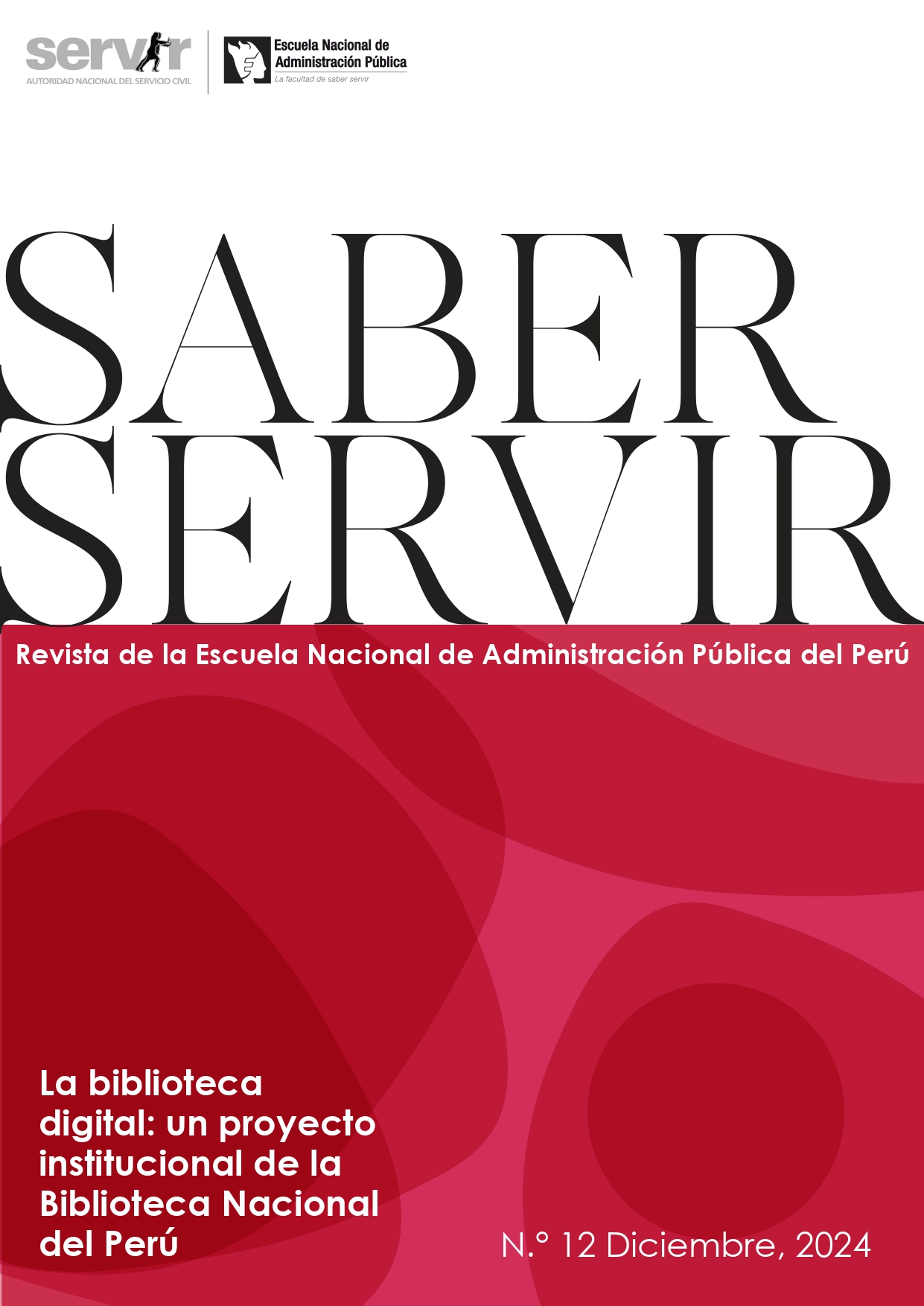
Los contenidos publicados en la revista están bajo una licencia CC-BY 4.0, la cual permite:
- Compartir, copiar y redistribuir el material en cualquier medio o formato.
- Adaptar, remezclar, transformar y construir a partir del material para cualquier propósito, incluso comercialmente.
Bajo los siguientes términos:
- Atribución. Usted debe dar crédito de manera adecuada, brindar un enlace a la licencia, e indicar si se han realizado cambios. Puede hacerlo en cualquier forma razonable, pero no de forma tal que sugiera que usted o su uso tienen el apoyo de la licenciante.
Todos los autores deben descargar, completar, firmar y remitir a través del correo electrónico de la revista revistaenap@servir.gob.pe, la siguiente DECLARACIÓN JURADA DE AUTORÍA Y CESIÓN DE DERECHOS DE AUTOR como requisito indispensable para la publicación del artículo.
Abstract
The current public sector faces a critical challenge: attracting exceptional talent. This task is
crucial for strengthening institutional capacity and enhancing the quality of government services.
Therefore, it is urgent to implement effective strategies for early attract and retain high-caliber
professionals whose expertise and dedication to public service can serve as catalysts for a more
efficient and citizen-oriented administration.The study explores the University Extension Course
in Environmental Control (CEU, in Spanish), designed and developed by the Environmental
Assessment and Enforcement Agency (OEFA, in Spanish) of Peru. Initially, the CEU course
aims to promote university students’ interest in environmental oversight topics. In recent years, this
course was developed as a strategy to attract specialized talent in environmental control, allowing
top students from each specialty to undertake internships at OEFA facilities nationwide.
Attracting specialized talent is a key pillar in the organizational realm, essential for incorporating
highly skilled and motivated professionals. Strategies in this regard include a set of actions specifically designed to attract university students with skills and competencies aligned with the
organization’s needs and objectives. Among the main strategies is the implementation of training
and specialization programs targeting students in the fields of science, law, and economics.
A description of the CEU is provided, offering a general explanation of the stages of design,
enrollment, participation, and results. These stages help to understand how the implementation
of a training and specialization program in environmental oversight contributes to ensuring the
success and the competitiveness of the OEFA. The results are presented in terms of participation
by gender, type of university, regions, and specialty. This article contributes to the academic
debate on human resource management in the public sphere, offering valuable insights and
lessons learned that can inform future practices and policies in this sector.
Keywords
References
Arenas Valenzuela, Y. A. (2023). Investigación sobre la discapacidad intelectual (DI) de niños/as en el contexto de vulnerabilidad socioeconómica en dos escuelas especiales del Servicio Local de Educación Pública Barrancas del Área Metropolitana. Facultad de Humanidades y Tecnologías de la Comunicación Social, Escuela de Trabajo Social. Universidad Tecnológica Metropolitana.
Ballew, M.; Pearson, A.; Goldberg, M.; Rosenthal, S. & Leiserowitz, A. (2020). Does socioeconomic status moderate the political divide on climate change? The roles of education, income, and individualism. Global Environmental Change-Human and Policy dimensions, 60.
Bijou, S. W.; Peterson, R. F. & Ault, M. H. (1968). Integrating field studies, data, and empirical concepts. Journal of Applied Behavior Analysis, 1(2), 175-191.
Bosc, R.; Bourque, M. & Dionne, S. (2022). Talent management in public administration: Toward public service attractiveness. Canadian Public Administration, 65(1), 64-89.
Cravino, J.; Machado, F. & Vásquez, E. (2020). Talent attraction and retention in public sector organizations in Latin America. Revista de Administração Pública, 54(6), 1647-1665. OEFA. (2024). Presentación. Curso de Extensión Universitaria. Fiscalización Ambiental. https://www.oefa.gob.pe/ceu2024/presentacion.php
Da Silva, A. (2023). A extensão universitária: uma experiência de ensino-aprendizagem que ajuda desenvolver as habilidades e competências dos estudantes de direito. Revista Eletrônica Direito e Sociedade - REDES, 11(2). https://doi.org/10.18316/redes.v11i2.9804
Decreto Supremo N.° 013-2017-MINAM. Reglamento de Organización y Funciones del OEFA (vigente) (20 de diciembre de 2017). https://www.gob.pe/es/l/1211414
Deloitte. (2022). The Deloitte Global 2022 Gen Z and Millennial Survey. https://www.deloitte.
com/global/en/issues/work/genzmillennialsurvey-2022.html
Hazelkorn, E. (2011). Rankings and the Reshaping of Higher Education. Palgrave Macmillan UK eBooks. https://doi.org/10.1057/9780230306394
Jacobson, W. S.; Selden, S. C. & Yeow, J. (2020). Attracting and retaining talent in the public sector. En Handbook of Human Resource Management in the Public Sector. Edward Elgar Publishing.
Ortiz-Riaga, M. C. & Morales-Rubiano, M. E. (2011). University Extension in Latin America: Concepts and Trends. Educación y Educadores, 14(2), 349-366. https://doi.org/10.5294/edu.2011.14.2.6
Ramaditya, M.; Maarif, M.S.; Affandi, J. y Sukmawati, A. (2022). Reinventar la gestión del talento: cómo maximizar el desempeño en la educación superior. Fronteras en la educación, 7, 929697. https://doi.org/10.3389/fed-uc.2022.929697
Resolución N° 5. Para la renovación de la enseñanza y la curricularización de la extensión y las actividades en el medio. Universidad de la República Uruguay. Consejo Directivo Central. (27 de octubre de 2009). https://www.expe.edu.uy/expe/resoluci.nsf/4e1fd2c2a317193a03256dcc003b902f/f200247a7f556d23032576550069e060?OpenDocument
Sampieri, H. (2014). Metodología de la investigación (6a ed.). McGraw Hill Education.
Stebbins, R. A. (2001). Exploratory research in the social sciences. Sage Publications.
Thunnissen, M. & Gallardo-Gallardo, E. (2019). Talent management in the public sector: A study of job analysists’ recruitment in Dutch public organizations. Revista de Administração Pública, 53(4), 717-737.
Veal, A. J. (2006). Research methods for leisure and tourism: A practical guide. Pearson Education Limited.
Wray-Lake, L.; Syvertsen, A. K. & Flanagan, C. A. (2022). Civic engagement during the transition to adulthood: Developmental opportunities and perspectives from research. American Psychologist, 77(6), 801–817.
Yamen, A. & Hajar, A. (2022). Employer branding and talent attraction strategies in public sector organizations. Public Organization Review, 22(2), 425-445.











